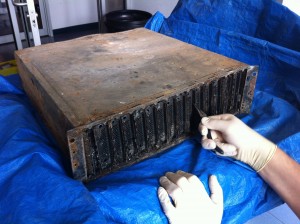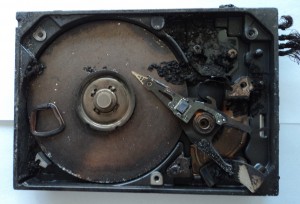
Our engineer removing a hard drive from a fire-damaged RAID.
Data recovery from fire-damaged RAID servers is frequently possible; each year, we receive several dozen cases (sometimes more, such as when wildfires impacted California business in early 2025), and most cases result in a full or partial recovery.
However, fire-damaged RAIDs are always complex cases. For systems with hard disk drives (HDDs), magnetic platters are often surprisingly resilient to heat, but the components required to read that data are extremely fragile. Solid-state drives are generally more resilient to physical damage, but less resilient for certain types of electronic damage.
The data recovery process is a multi-stage operation requiring a certified cleanroom and extensive engineering expertise. If you’ve lost data due to a fire, flood, or other natural disaster, call 1-800-237-4200 to speak with a RAID recovery specialist or submit a case online.
Protecting Your RAID Data Following a Fire
What you do in the first 24 hours following the fire can influence data recovery outcomes.

The platters of a fire-damaged drive.
In most cases, fire-damaged servers will begin to corrode immediately. This is the primary threat after the fire is out: The combination of water or chemical fire suppressants with acidic, conductive soot creates a corrosive mixture that needs to be removed as soon as possible.
On an HDD, corrosion can destroy the electronics. On an SSD, it can permanently fry the controller chip and make data on the NAND flash unreadable.
Above all, do NOT attempt to power on the server or the drives.
For both HDDs and SSDs, powering on the server will send a current through components that are already contaminated with that conductive soot and moisture.
Additionally:
- DO NOT attempt to clean the drives. Wiping soot or residue can force abrasive particles into an HDD’s chassis or short-circuit connections on an SSD board.
- DO NOT try to initiate a RAID rebuild. The array is in a failed state. Attempting a rebuild will fail. At worst, it may corrupt parity data, leading to logical data corruption.
- DO NOT dry the drives with compressed air or external heat (like a hair dryer).
- DO contact a professional data recovery service immediately.
Data recovery engineers can clean fire-damaged media, limiting the extent of the damage and optimizing the chances of a full recovery. Datarecovery.com operates real laboratories with certified cleanrooms at every location — no mailing offices — and all of our facilities are outfitted to handle RAID media. Set up an evaluation online.
Failure Points for Fire-Damaged Raids
“Fire-damaged” is not a complete diagnosis; engineers must determine which components of a device are salvageable and which require replacement. Here’s an overview of failure points for HDDs, SSDs, and controller cards.
For Hard Disk Drives (HDDs)
- Thermal Damage: Intense heat can cause differential expansion, warping the HSA (Head Stack Assembly) or causing the spindle motor to seize.
- Corrosion: Corrosion can affect both the printed circuit board (PCB) and mechanical components.
- Particulate Contamination: Soot is a fine, abrasive, and conductive particulate. If it gets inside the drive’s housing, it can cause a head crash, which can result in physical media damage.
For Solid-State Drives (SSDs)
- Thermal Damage: The controller chip and NAND flash chips can de-solder from the board. Extreme heat can also degrade the NAND flash cells themselves, causing data degradation (loss of charge).
- Corrosion & Short Circuits: TThe PCB is densely packed with tiny surface-mount components. Soot and water will create thousands of micro-short circuits, destroying the SSD controller, the RAM cache, and the NAND flash chips.
- Controller Chip Damage: Data on an SSD is scrambled (via wear-leveling and garbage collection) across the NAND chips by the controller. If the controller chip is physically destroyed by fire/water, the data on the NAND chips is essentially encrypted. Recovery then requires “chip-off” techniques, which are relatively complex.
For the RAID Controller Card
- Hardware Failure: The RAID controller is just as vulnerable as any other PCB. Thermal damage can warp the board, and the corrosive mix of soot and water will cause short circuits.
- Loss of Configuration: The controller card often stores the RAID array’s metadata that defines which drives are in the array, their order, the stripe size, and the parity rotation. When the card is destroyed, this configuration is lost.
All of these issues are addressable in a professional laboratory, but the prognosis for data recovery depends on the extent of the damage, the type of files stored on the RAID, and various other factors.
How RAID Impacts Physical Data Recovery
Recovering a single fire-damaged drive is difficult. Recovering a fire-damaged RAID array is much more complex, since the array will need to be reconstructed to restore the data to a usable state.
A successful data recovery process will:
- Recover every individual drive (or at least enough drives to satisfy the array’s parity requirements).
- Create a stable, bit-by-bit image of each of those drives.
- Reverse-engineer the array’s original configuration.
As a leader in professional RAID disaster recovery services, we maintain an extensive inventory of controller cards, hard drives, SSDs, and other hardware. Our inventory allows us to perform physical repairs quickly, while advanced imaging equipment enables our engineers to restore data to a working condition as quickly as possible.
Related: A Look Inside Datarecovery.com’s Hardware Inventory.
The Professional Lab Recovery Process for Fire-Damaged RAID
All fire-damaged media must be treated in a certified cleanroom, particularly during the critical first stages of the process:
- Decontamination: Each drive is immediately moved to a cleanroom environment. The components are meticulously cleaned with non-corrosive chemical solutions to neutralize the acidic residue and remove all particulates.
- Hardware-Level Repair (HDDs): Engineers may replace the fire-damaged PCB with a compatible donor board, transferring the drive’s original ROM chip (which holds unique calibration data) via micro-soldering. If the internal mechanics are damaged, they may also replace the HSA (Head Stack Assembly) or, in cases of a seized motor, carefully move the platters to a new chassis. The exact methods used will vary depending on the extent of the damage.
- Hardware-Level Repair (SSDs): If the controller chip is intact, the goal is to replace the board. If the controller is destroyed, chip-off procedures are used to read individual NAND chips; from here, we can attempt to reverse-engineer the controller’s wear-leveling and error-correction algorithms and reassemble the data.
- Drive Imaging: We use hardware-level imagers to create a bit-by-bit copy of each drive. Imaging the media ensures that the rest of the process is nondestructive (meaning that the logical procedures won’t endanger your original media).
- Virtual RAID Reassembly: RAID engineers analyze the data to determine the correct array parameters (like drive order, stripe size, and parity) and build a virtual array.
- Data Extraction and Validation: We check the file system for logical corruption and extract the data to return media.
Data Recovery Resources for Fire-Damaged RAID Arrays
Fire-damaged RAID servers are typically recoverable, but the timeframe matters. The best course of action is to contact a professional data recovery provider as soon as possible.
At Datarecovery.com, we have decades of experience with these worst-case scenarios. Through our no data, no charge guarantee, you don’t pay a recovery fee unless we successfully recover the data you need.*
Contact our experts 24/7 at 1-800-237-4200 or submit a case online to get started.
*Note: Fire-damaged RAID systems require extensive cleaning during the evaluation process. For that reason, we may assess evaluation fees, which are separate from recovery fees; evaluation fees are not covered by the no data, no charge guarantee. Speak with a technical service representative to learn more.




